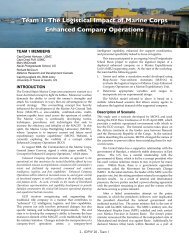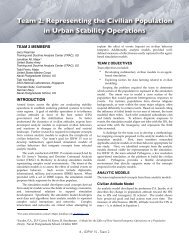pdf file - SEED Center for Data Farming - Naval Postgraduate School
pdf file - SEED Center for Data Farming - Naval Postgraduate School
pdf file - SEED Center for Data Farming - Naval Postgraduate School
Create successful ePaper yourself
Turn your PDF publications into a flip-book with our unique Google optimized e-Paper software.
Team 3: Using <strong>Data</strong> <strong>Farming</strong> to Develop and<br />
Evaluate IED Scenarios <strong>for</strong> PAX<br />
TEAM 3 MEMBERS<br />
SEICHTER, Stephan LtCol<br />
Bundeswehr Trans<strong>for</strong>mation <strong>Center</strong>, Germany<br />
LAMPE, Thorsten<br />
MALY, Andreas<br />
EADS System Design Centre, Germany<br />
ANG, Chee Chien<br />
DSO National Laboratories, Singapore<br />
THOMPSON, Meredith<br />
NPS, <strong>SEED</strong> <strong>Center</strong> <strong>for</strong> <strong>Data</strong> <strong>Farming</strong>, USA<br />
WHITNEY, Laura<br />
NPS, <strong>SEED</strong> <strong>Center</strong> <strong>for</strong> <strong>Data</strong> <strong>Farming</strong>, USA<br />
INTRODUCTION<br />
The Bundeswehr Trans<strong>for</strong>mation <strong>Center</strong> is examining how<br />
M&S can effectively support Concept Development and<br />
Experimentation (CD&E) projects analyzing different aspects<br />
of stabilization operations. Human Factors and Human<br />
Behavior analyses have been highly relevant in this context.<br />
Current studies examine the use of the agent-based model<br />
PAX <strong>for</strong> this purpose. These studies include Humanitarian<br />
Assistance scenarios in response to disaster-caused refugee<br />
movements and Irregular Warfare scenarios modeling<br />
asymmetric tactics instead of <strong>for</strong>ce-on-<strong>for</strong>ce engagements.<br />
The analysis focuses on situations in which the <strong>for</strong>ces are<br />
facing adversaries using improvised weapons, namely<br />
Improvised Explosive Devices (IEDs).<br />
Scenario<br />
The current scenario being analyzed with the model PAX<br />
takes place inside a refugee camp operated by the German<br />
military. The scenario has 60 civilian agents of the same<br />
ethnic group; there<strong>for</strong>e, we assume that there are no acts of<br />
aggression among the civilians themselves.<br />
Because the current focus of the analysis is to develop a<br />
realistic behavior <strong>for</strong> the civilians in the refugee camp looking<br />
to the possible outcomes such weapons would have on<br />
civilian populations, the scenario does not contain any<br />
military personnel yet, even though the camp is assumed to<br />
be run by the military.<br />
At the beginning of the scenario an IED detonates among<br />
a group of civilians. The explosion harms several agents<br />
standing close to the IED, while other agents residing outside<br />
the area of the detonation do not suffer any injury.<br />
The further course of the simulation is then controlled by<br />
the direct and indirect effects of the explosion on the civilians'<br />
physical as well as emotional conditions.<br />
Figure 1 depicts the initial setup of the refugee camp<br />
scenario that was used as the baseline <strong>for</strong> the studies<br />
per<strong>for</strong>med during the week of the workshop.<br />
Questions<br />
In preparation <strong>for</strong> the workshop, major adjustments had<br />
been made to integrate civilian behavior in response to an<br />
IED explosion into the model PAX. As a result, the team was<br />
able to work with the model itself during the workshop, and<br />
view and review the current status of the implementation<br />
and scenario.<br />
Among the effects that had already been considered and<br />
integrated into the model were<br />
• possible physical damage caused by the IED,<br />
depending on the actual size of the IED<br />
• emergence of fear among the agents who witness the<br />
detonation<br />
• emergence of fear among the agents who recognize<br />
the detonation's effects in wounding or killing fellow<br />
civilians<br />
• emergence of curiosity among agents once their fear<br />
has subsided<br />
• emergence of a motivation of helpfulness towards<br />
injured agents after the detonation<br />
The primary goal during IDFW20 was to use <strong>Data</strong><br />
<strong>Farming</strong> and single run analysis to evaluate and further<br />
develop the current IED scenario in order to more accurately<br />
9 - IDFW 20 - Team 3




